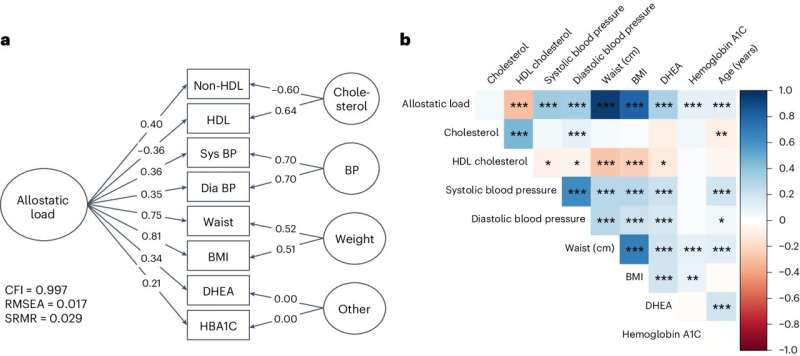This article has been reviewed according to Science X's editorial process and policies. Editors have highlighted the following attributes while ensuring the content's credibility:
fact-checked
peer-reviewed publication
trusted source
proofread
Genetics, environment and health disparities linked to increased stress and mental health challenges during adolescence

A new study from researchers at Children's Hospital of Philadelphia (CHOP) reveals that the cumulative "wear and tear" on the body known as allostatic load (AL) can be measured in early adolescence and that childhood adversity correlates with increased stress and mental health challenges during adolescence. The findings were published today in the journal Nature Mental Health.
Since the COVID-19 pandemic began, children and teens have experienced an influx of behavioral health challenges. Driven by CHOP's strong commitment to addressing the pediatric mental health crisis, researchers aimed to quantify how the exposome, environmental exposure, "gets under the skin" and affects physiological systems and mental health, further testing how differences in exposome can explain health disparities. The authors further tested gene-environment mechanisms that lead to AL, with the idea that better understanding how stress influences physical and mental health could potentially improve prevention and intervention strategies.
"The collective wisdom has been that if you are chronically exposed to stress, your body pays a price, but that it happens over time," said Ran Barzilay, MD, Ph.D., psychiatrist with the Youth Suicide Prevention, Intervention and Research Center at CHOP and the study's lead author. "Our data shows that while less developed, we can quantify AL in adolescents as young as 12 years old and link it to childhood adversity and inequity."
In the study, conducted by Kevin Hoffman, MD, Ph.D., a child and adolescent psychiatry fellow at CHOP, the research team analyzed data of more than 5,000 diverse youth, averaging 12 years old, from the longitudinal Adolescent Brain Cognitive Development Study. They calculated a latent AL score using body mass index, waist circumference, blood pressure, blood hemoglobin-A1C, blood cholesterol, and salivary dehydroepiandrosterone (DHEA) hormonal levels.
Childhood exposomic risk was determined by reviewing their environment before age 11 through lifestyle factors like diet, exposure to abuse, poverty, and pollutants. Genetic risk was quantified by using polygenic risk scores for metabolic issues, such as type 2 diabetes (T2D), and psychiatric conditions such as major depressive disorder (MDD).
Using linear mixed-effects models, researchers evaluated the interplay between exposomic and polygenic risks and their impact on AL. Overall, they found that an association between childhood environmental exposures and adolescent AL was stronger in individuals with higher genetic risk of T2D and MDD. The study also showed that environmental factors like childhood adversity, such as abuse, family dysfunction and poverty increased AL, which in turn influenced mental health outcomes in teens.
"The findings expand existing literature suggesting a mediating role of AL from childhood adversity to adult mental health and support the hypothesis that AL could be a mechanism that contributes to health disparities," Barzilay added. "Critically, we show evidence of disparities in AL at an early age, well before expected onset of many chronic medical illnesses."
For example, non-Hispanic white youth had significantly lower AL compared to Hispanic and non-Hispanic Black youth. Childhood environmental burdens, such as day-to-day challenges in the home and community were linked to higher AL in adolescence.
Given the severe health disparities in America, researchers hope the findings propel more studies in diverse populations, where AL measurements can improve their understanding of differences in pediatric health outcomes and related inequities.
"The future of mental health is precision medicine, which allows holistic understanding of how the individual and structural environment, and genes, contribute to health outcomes in early age, both from a physical and mental health perspective," said Barzilay.
More information: Kevin W. Hoffman et al, Exposomic and polygenic contributions to allostatic load in early adolescence, Nature Mental Health (2024). DOI: 10.1038/s44220-024-00255-9



















